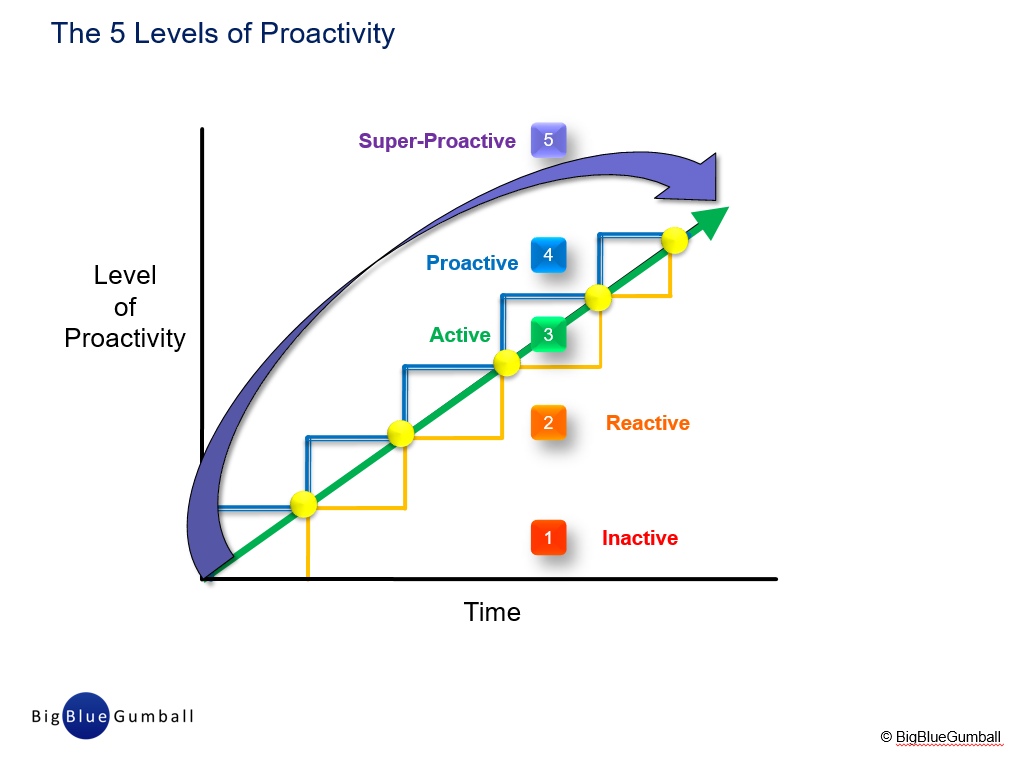 Todd Cherches | Comments Off |
Todd Cherches | Comments Off |  Careers,
Careers,  Management,
Management,  leadership,
leadership,  levels,
levels,  proactivity,
proactivity,  success
success  Wednesday, November 16, 2016 at 6:32PM
Wednesday, November 16, 2016 at 6:32PM 
Do you wait for things to happen . . . or do you make them happen?
Do you find yourself stalling for the perfect time to take action…or do you make “now” the right time?
Do you always find yourself one or more steps behind and playing catch-up…or do you go about your business feeling confidently and comfortably ahead of the curve?
Whether we’re talking about your personal life or your career, one of the most overlooked keys to success is the level of “proactivity” at which you tend to operate.
Life and work are filled with daily barriers, obstacles, and challenges that stand in the way of our getting things done. For example:
There are probably other factors as well. But if you look at this particular list, what all these reasons have in common is that they are all INTERNAL…and, therefore, all within our control.
HOW PROACTIVE ARE YOU?
Here is a simple-yet-powerful model that we call “The 5 Levels of Proactivity.” Let’s explore it from the bottom up to see how we can work our way up from being Inactive, to Reactive, to Active, to Proactive, and, ultimately, to Super-Proactive:
Level 1: INACTIVE. At this level, something is needed from you…and you do nothing. Absolutely nada. Zero. Zilch. For whatever reason, you decide to take no action at all. Maybe the problem or request will just go away by itself. But probably not.
Level 2: REACTIVE. At this level, something is needed, and you respond. This is actually a good thing! So congratulations – you’ve put out the fire. The only problem is if you are constantly in reactive, fire-fighting mode, you are always at least a step behind. After a while, as the speed of needs and expectations increases, you may fall so far behind that you are unable to catch up. And then people are constantly waiting for you, getting frustrated and impatient…until they decide to look elsewhere for what they need.
Level 3: ACTIVE. When you are at this level, you are keeping up with demand, giving people what they want and need, in real-time, when they need it, and meeting expectations. Things are going well, and you are keeping up with the pace. The only problem is that when you are just keeping pace, you are not getting ahead. At this level, there is no time or space for growth. You’re getting things done, but you’re either treading water or standing still. And in an ever-changing world, if you’re standing still, you’re falling behind.
Level 4: PROACTIVE. Now we’re getting somewhere! At this level you are not only keeping up with the pace, but setting the pace and staying a step ahead. You are not just putting out fires, you’re preventing them. You are not just meeting expectations, you’re exceeding them. Anticipating others’ needs and expectations, you are thinking on your feet, doing your homework, looking down the road, putting yourself in the shoes of your customers, fostering an environment of growth and development for yourself and others, and taking control of your destiny. Remember that the root word of “pro-act-ivity” is “act” – and you are ready, willing, and able (and excited) to ACT!
Level 5: SUPER-PROACTIVE. Now you are not just setting the pace…you are leading! With a vision of the future, you are thinking not just one step ahead, but many steps ahead. This is where innovation happens, this is where paradigms shift, this is how you drive change and blow people away. This is where you develop your reputation as a guru of, or the go-to person for, things. The leaders of the future are those who are able to meet the demands of today while consistently anticipating and exceeding the needs of tomorrow. You anticipate what people want and need before they even realize it. You are a visionary. And as management guru Peter Drucker famously said, “The best way to predict the future is to create it.”
That’s the model in a nutshell. Now let’s bring it to life with a simple, practical, real-life example: Let’s say it’s January 1st and you decide you want to get in shape for the summer.
If you’re INACTIVE, you don’t do anything about it. You procrastinate, you say, “It’s only January. I can wait a few months to get started.” But didn’t you just “decide” you were going to take action? That reminds me of the old riddle: There are five frogs sitting on a log, and one decides to jump in the water. How many frogs are now sitting on the log? The answer: Still five. One “decided” to jump in, but he didn’t actually DO it. It’s not the “deciding,” but the “doing” that counts.
If you’re REACTIVE, you’ll work out if someone else drags you along to the gym, or you’ll eat better if someone else shops for healthier food and places it in front of you. But you are not in control, and you are not taking responsibility, driving the changes, or owning the behavior necessary to achieve your desired outcome.
If you’re ACTIVE, you’ll get off the couch and work out if the mood hits you, and you’ll have an occasional low-calorie fruit juice or water rather than a soda. And you’ll replace that Big Mac with a salad. Your intentions are good, you’re taking baby steps, and you’re trying, but it’s sporadic and undisciplined, and you don’t really have a plan.
When you’re PROACTIVE, you make a plan – a structured, formalized, written plan, and you stick to it. You put a process in place and set a quantifiable goal of working out x days a week – no excuses. Your diet plan includes the sacrifices you’re willing to make...and you keep those commitments without fail. You follow through and you follow up. You make real behavior changes and track the results, with no excuses and no exceptions.
And what would being SUPER-PROACTIVE look like? It’s about having a longer-term time horizon and thinking many steps ahead. It’s about imagining the possibilities and anticipating potential obstacles that may arise down the road. Perhaps thinking and planning beyond the summer, into the fall, winter, spring, and maybe even into following year. Always thinking and acting with the big picture and a long-term vision of the future in mind.
So that’s just one example. How might YOU use this model to be more proactive in your personal life? To be less stressed? More productive? Happier? To take charge of your career? To get more things done? To impress your boss, to better serve your (internal and external) customers, or to be a more effective manager and leader?
How important is proactivity? In Stephen Covey’s classic book The 7 Habits of Highly Effective People, “Be Proactive” is Habit #1. That’s how important it is.
It’s not easy being proactive; it takes time, attention, energy, discipline, and vision. But the good news is that the decision to be more proactive is entirely up to you and completely within your control. And it’s never too late to get started. As Confucius said, “The best time to plant a tree was twenty years ago; the next best time is today.”
And while being more proactive – and super-proactive – may involve making some radical changes and taking some substantial risks, as the saying goes: sometimes we just have to go out on a limb…because that’s where the fruit is.

 Todd Cherches | Comments Off |
Todd Cherches | Comments Off |  Careers,
Careers,  Management,
Management,  leadership,
leadership,  levels,
levels,  proactivity,
proactivity,  success
success